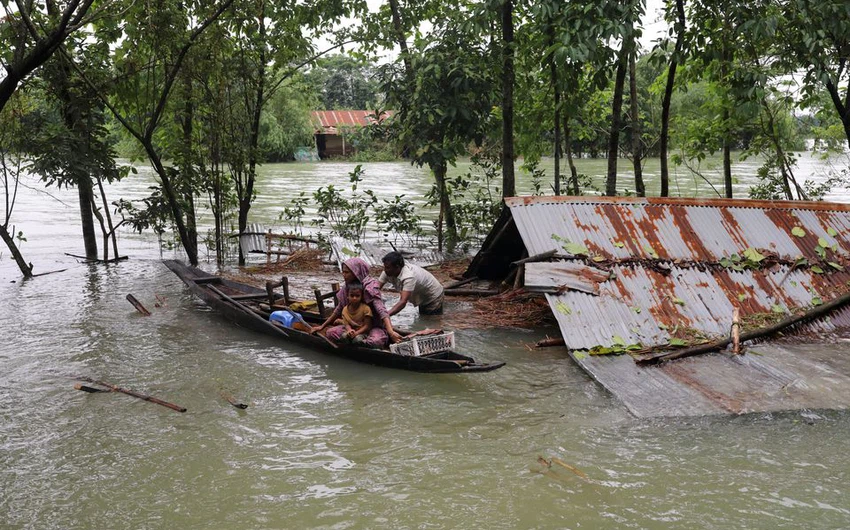The catastrophic floods in Bangladesh raise climate warnings, pushing the region towards more disasters
<p style=";text-align:left;direction:ltr"><strong>Weather of Arabia</strong> - In a catastrophic event that raised climate warnings, experts have suggested the cause of the floods that hit Bangladesh on Saturday to climate change, which may have made the rains that caused the floods worse.</p><p style=";text-align:left;direction:ltr"></p><p style=";text-align:left;direction:ltr"> The floods that inundated large parts of northeastern Bangladesh and India due to monsoon rains, which an expert in the Bangladesh government described as possibly the worst in the country since 2004, were exacerbated by the torrential rains that ran through the Indian mountains, causing extensive damage and killing dozens.</p><p style=";text-align:left;direction:ltr"></p><p style=";text-align:left;direction:ltr"> Scientists say that while the monsoons in South Asia follow normal atmospheric patterns, the rains will become more variable and heavier as global temperatures continue to rise.</p><p style=";text-align:left;direction:ltr"></p><p style=";text-align:left;direction:ltr"> It may take months to determine how much of a role climate change played in last week's torrential rains, but scientists note that warmer air can hold more water vapor before rain clouds eventually explode, meaning more rain.</p><p style=";text-align:left;direction:ltr"></p><p style=";text-align:left;direction:ltr"> <strong>Video and photos | <a href="https://www.arabiaweather.com/ar/content/%D8%A8%D8%A7%D9%84%D9%81%D9%8A%... monsoon floods in Bangladesh and India kill dozens and make millions homeless</a></strong></p><p style=";text-align:left;direction:ltr"></p><h2 style=";text-align:left;direction:ltr"> <span style="color:#FF0000;"><strong>The South Asian monsoon season and climate change</strong></span></h2><p style=";text-align:left;direction:ltr"> The South Asian monsoon season, from June to September, is governed by several overlapping ocean and atmospheric patterns, including the El Nino-La Nina and Indian Ocean dipole weather cycle. Strong southwesterly winds over the Bay of Bengal.</p><p style=";text-align:left;direction:ltr"></p><p style=";text-align:left;direction:ltr"> But monsoon patterns have changed in recent decades, with the average temperature in Bangladesh having risen by at least 0.5°C since 1976.</p><p style=";text-align:left;direction:ltr"></p><p style=";text-align:left;direction:ltr"> "Strong monsoons in the Bay of Bengal can carry a lot of moisture," said Roxy Matthew Cole, a climatologist at the Indian Institute of Tropical Meteorology. "The massive amount of rain we're seeing now may have an impact from climate change."</p><p style=";text-align:left;direction:ltr"></p><p style=";text-align:left;direction:ltr"> "Instead of moderate rain during the monsoon season, we have intermittent long droughts with short bouts of heavy rain," Cole added. "When it rains, it gets rid of all that moisture within a few hours to a few days."</p><p style=";text-align:left;direction:ltr"></p><p style=";text-align:left;direction:ltr"> On Tuesday, Bangladeshi forces were sailing boats through the salty flood waters to rescue the needy and deliver food and water to some of the affected among the 9.5 million stranded people, and officials say at least 69 people died in the disaster.</p><p style=";text-align:left;direction:ltr"></p><p style=";text-align:left;direction:ltr"> Last week's torrential rains that caused rivers to overflow in Bangladesh came less than a month after the neighboring Indian state of Assam was hit by similar floods caused by heavy rain, killing at least 25 people there.</p><p style=";text-align:left;direction:ltr"></p><p style=";text-align:left;direction:ltr"></p><h2 style=";text-align:left;direction:ltr"> <span style="color:#FF0000;"><strong>Bangladesh is one of the countries in the world most vulnerable to the effects of climate change</strong></span></h2><p style=";text-align:left;direction:ltr"> Bangladesh is one of the world's most climate-vulnerable countries, with a 2015 analysis by the World Bank Institute estimating that about 3.5 million Bangladeshis are at risk of river flooding each year. The floods also threaten the country's agriculture, infrastructure and clean water supply.</p><p style=";text-align:left;direction:ltr"></p><p style=";text-align:left;direction:ltr"> The countries in the region "all suffer if there is no rain, and they also suffer when it rains heavily," said Anders Levermann, a climate scientist at the Potsdam Institute for Climate Impact Research and Columbia University. "What the region needs is constant rainfall, as it was happening in the past, which is now subject to change due to global warming."</p><p style=";text-align:left;direction:ltr"></p><p style=";text-align:left;direction:ltr"> <strong><a href="https://www.arabiaweather.com/ar/content/%D9%83%D9%8A%D9%81-%D8%AA%D8%AD... the monsoon turns the Indian subcontinent from a wasteland to a flood during the summer</a></strong></p>
Arabia Weather App
Download the app to receive weather notifications and more..







